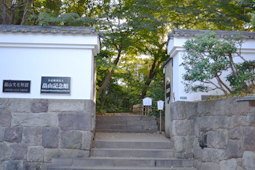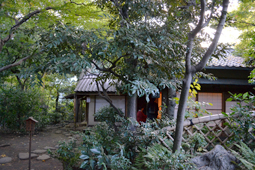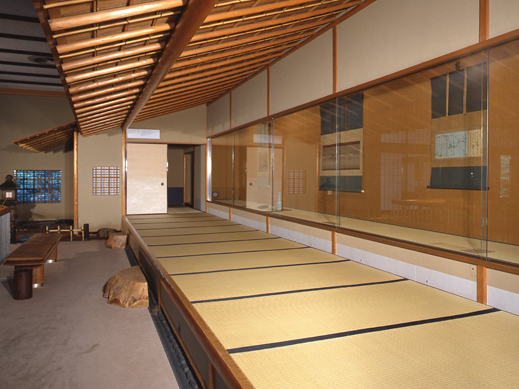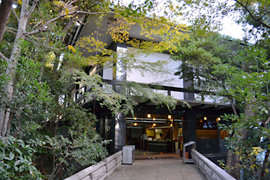 |
|
Focus features two in-depth reviews each month of fine art, architecture and design exhibitions and events at art museums, galleries and alternative spaces around Japan. The contributors are non-Japanese art critics living in Japan.
|
|
|
 |
 |
 |
An Oasis for the Art and Arts of Tea: The Hatakeyama Memorial Museum
Michael Pronko |
 |
 |
|
 |
The museum entrance feels like it should be flanked by armed guards, but inside, curving stone walkways and bamboo fences lead through the garden past tearooms to the museum.
|
|
A bust of Issei Hatakeyama near the entrance watches over visitors as they enter the large grounds. |
Tucked away on a backstreet in the classy Shirokanedai area of Tokyo, the Hatakeyama Memorial Museum of Fine Art is an excellent venue for the exhibiting, and experiencing, of traditional Japanese artworks. The long, thick white walls enclose a large garden dotted with tearooms. The modern museum building is hidden behind dense foliage, and opens into a marvelous space for its collection of art devoted to the tea ceremony.
The museum is the lifework of Issei Hatakeyama (1881-1971, also known as Sokuo), the founder of Ebara Corporation. Born into the family of a feudal lord of Nanao Castle in Noto Province (now Ishikawa Prefecture), Hatakeyama left for Tokyo after the collapse of the clan system. He eventually graduated from a technical college, after which he began developing and marketing pumps. His company now produces engineering, environmental and precision machinery. Most importantly for the art world, his business success allowed him to pursue his true love -- the tea ceremony.
In the early Showa period, Hatakeyama bought a Tokyo nobleman's large estate, which now houses the museum and tearooms, and began collecting tea utensils and performing the tea ceremony. The entire complex derives its calming and vigorous aesthetic from the art of tea. The garden is quiet and relaxed, though when tea ceremony clubs meet there, the stone walkways are filled with students in kimono, bustling from tearoom to tearoom.
The museum was opened in 1964 to display to the public Hatakeyama's extensive collection of tea service utensils and other artwork. The collection of scrolls, paintings, lacquerware, pottery, and cloth items includes six pieces designated as National Treasures and 32 works designated as Important Cultural Properties of Japan, as well as works from China and Korea.
 |
|
 |
| One of the tearooms where practitioners of the art of tea hold regular meetings, classes, and ceremonies. |
|
The casual, loose style of the garden blends well with the wabi-sabi aesthetic of the museum grounds. Tea enthusiasts hurry in to a ceremony.
|
The exhibits change with the season and focus on a theme related to the time of year, an important anniversary, or a specific era and style. The second-floor exhibition space is large enough to impress, but small enough to take in completely. The display cases are well spaced so the visitor does not have to cram in and look over anyone's head. The interior is designed for contemplation of the objects, not a rush-through must-see tour. Tatami mats along one wall allow one to kneel and contemplate selected works, and a tearoom in the corner, set off by a small rock garden, offers space to meditate in even more depth.
The current autumn exhibition through 16 December is particularly impressive. Rikyu and Oribe: Preferences and Brilliant Physical Metaphors of the Tea Masters focuses on two of the most famous tea masters, Sen no Rikyu (1522-91), who originated the tea ceremony under the warlords Oda Nobunaga and Toyotomi Hideyoshi, and his disciple, Furuta Oribe (1544-1615), who continued the tradition by adding his own expressive elements. The current exhibit contains many of their personal tea utensils from the 16th and 17th centuries.
Most spectacular is a vase named Karatachi which seems to contain the essence of a tea master's sensibility. Designated an Important Cultural Property, the relatively tall vessel feels alive with organic proportions and earth colors, its lip bending to one side. A bamboo rest for a teakettle lid used by Sen no Rikyu conjures images of what it might have been like to attend a ceremony with him. Those images are all the more easily summoned by the tearoom in the corner, and by the obvious excitement of the many devotees of tea ceremony pondering the exhibit.
 |
The interior of the museum allows for calm reflection and slow viewing of the artworks. Without any need to hurry through, visitors can relax and enter into the spirit of the pieces, which is what the art of tea is all about.
Photo courtesy of the Hatakeyama Memorial Museum of Fine Art
|
The lacquerware tea containers, several of them wrapped in cloth, shine brilliantly even in the low, diffuse lighting of the interior. The tea bowls, though, are what really draw one's attention. With their soft contours and "just-right" cracks, they seem to be made of dough or soft earth rather than fired clay. The tea bowl from Korea with a notched foot must have been used to add an element of surprise to a tea ceremony, but all of the bowls have a dynamism and unique character that draws you into them. And yes, with a little reflection, you can almost taste the tea.
 |
The museum building, nicely veiled by greenery, holds the repository of the collection and the second-floor gallery space for seasonal exhibits.
Photos by Michael Pronko except where noted |
|
The Hatakeyama Museum is a lovely place to visit. Small and hidden demurely away from Tokyo's bustle, this unique space and the focused exhibits therein offer a retreat from the city, and an artistic and experiential delight.
 |
 |
Michael Pronko
Michael Pronko teaches American literature, film, art and music at Meiji Gakuin University. He has appeared on NHK, Sekai Ichiban Uketai Jugyo, and other TV programs. His publications include several textbooks and three collections of essays about Tokyo. He writes regular columns for Newsweek Japan, ST Shukan, The Japan Times, and for his own websites, Jazz in Japan and Essays on English in Japan.
|
|
 |
|